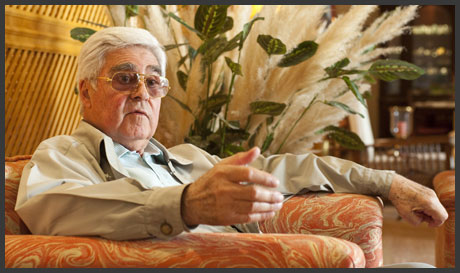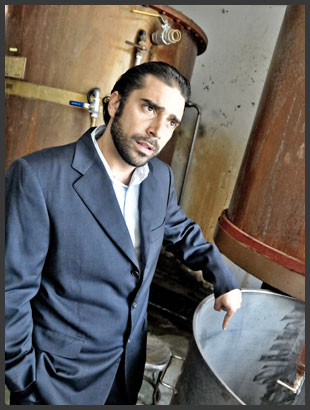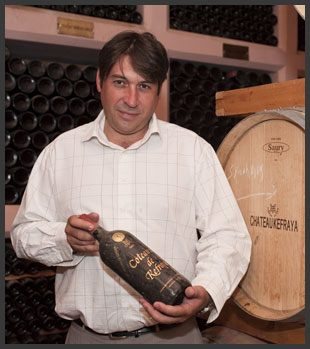Lebanon Wine – Making of Château Kefraya
We had our own wine made from our own grapes and from our own winery and thus from that point on we agreed to only use grapes from Kefraya. We started with white wine, rosé wine, and red wine and the Kefraya Nouveau. After this we created many more types of wine and now we have so many. We have three categories: Pleasure Wines, Feast Wines, and Prestige Wines.
 Château Kefraya was a part of this because we sold much more wine in the Lebanese market and this 39% increase in tourism impacts our business. Last year we saw that our restaurant “Le Relais Dionysos” and wine shop were important destinations for these tourists thus we were able to witness the tourism increase in action.
Château Kefraya was a part of this because we sold much more wine in the Lebanese market and this 39% increase in tourism impacts our business. Last year we saw that our restaurant “Le Relais Dionysos” and wine shop were important destinations for these tourists thus we were able to witness the tourism increase in action.
One of the big challenges for Lebanon’s tourism industry is sustainable tourism and having tourism 365 days a year. What do you think about this and what can be done in order to increase the tourism rate in winter?
Now tourism is primarily oriented toward the beach or visiting old temples and historic sites. I think that there is another side that people are missing out on like conferences or an opera house, for example. We can also develop educational and cultural tourism because these fields have been affected since the war. Medical tourism is also another area to look at because, in the past, people would come here seeking a good surgeon or doctor and this could run parallel to the tourism that we currently experience now. I also believe we could benefit from environmental tourism as it concerns the winery and the area surrounding it. We personally will develop our tourism around wine, the “oenotourism”.
Is seasonality a concern for you?
Of course, in Lebanon seasonality means at least six months of good conditions for us!
Located in the heart of Lebanon, the Bekaa Valley, Château Kefraya extends it lands of 300 acres on the foothills of Mount Baruk. What is the history of Château Kefraya?
It started out as an agricultural estate. We planted vineyards to diversify with what we had already. The grapes were sold to other wineries at that time. In 1979, we started to plan for the winery but we only built a third of it. Then, we had our own wine made from our own grapes and from our own winery and thus from that point on we agreed to only use grapes from Kefraya. We started with white wine, rosé wine, and red wine and the Kefraya Nouveau. After this we created many more types of wine and now we have so many. We have three categories: Pleasure Wines, Feast Wines, and Prestige Wines. In each family there are at least three colors or more in addition to sweet wines and the Nectar. We have always worked hard to maintain a high level of quality and we have always been concerned about th
e attractiveness of the package and presenting a beautiful product. We believe art should always accompany wine and all of Château Kefraya‘s bottles include some variation of a painting and an opera.
Can you give a message to our audience that will capture the soul of Château Kefraya wines?
“Château Kefraya is the work of a lifetime”. There is absolutely nothing in Château Kefraya that I haven’t personally developed or planted over the last fifty years. What is special is having the vineyard and winery in the same place and what is more poetic is the taste that differentiates the wine Château Kefraya has.
“Château Kefraya’s devise and therefore
Château Kefraya’s strategy is Semper Ultra,
which means “always higher, always better”.”
What would be your final message about Château Kefraya?
Come to Château Kefraya and see what we have to offer. We have a certain degree of autonomy because we have staff and maintenance workers who are able to provide their expertise internally. A symbol of this autonomy is the flag of Château Kefraya and people who come here will be able to experience these regional elements. We are also going to be able to offer tours of the vineyard and the area in addition to wine tastings and lunch at our venue and all of this will contribute to the unique experience Château Kefraya can provide.
Emile Majdalani, Commercial Director:
How would you describe Château Kefraya’s export strategy and how do you succeed in a market where competition is more intense than ever?
The general export strategy is to incur the maximum amount of countries and spread production all over the world. It is not a volume oriented strategy; what’s important for us is to be present everywhere. We have been collaborating with distributors for the past 3-4 years in South America and recently we started in Australia. We are ever expanding. Export wise when we distribute in a market we don’t want to only be in Lebanese restaurants but also in other ethnic restaurants. A Lebanese restaurant will always need your wine but the real challenge is taking high-end restaurants worldwide and integrating our off-trade profile.
What are your main challenges when exporting abroad?
The most challenging part is that you always have to introduce Lebanon when you talk about Château Kefraya. In some areas people do not have a lot of knowledge about the country and educating these people can be a challenge. You need to export the flag not just the product and transmit the knowledge through various channels. It is our role to disseminate our cultural history and make people aware of the story of wine as it relates to Lebanon.
How do you communicate this?
Only talking about the country or wine is not enough. International exhibitions are the best way to promote the wine. It allows talking to people, letting people taste, and taking your time in educating others. We have been doing this in France for several years now, we have been in Hong Kong this year, Italy, Mexico, and even in Belarus. It is very beneficial promoting wine this way.
How special are these wines? What is the type of soil and can you shed some light on your wine producing process?
In Kefraya we have a large variety of soils and these allow us to produce a variety of wines. The diversity of soil permits to have different tastes of grapes and this is the most important thing. Vinification is an art similar to the way artists blend colors: we do the same with Château Kefraya when we create varieties. In order to produce quality products you have to believe in what you are doing and have the patience to see the product through. You have to know how to mix tradition with modernity and last year we invested a lot in the winery to renovate and upgrade our technological capabilities, for example, optical selection for grapes in production. We are actually one of the ten wineries in the world to utilize this technology and still however, we respect tradition. Quality is the most important element for us as opposed to quantity. In Château Kefraya‘s three categories of wine, Pleasure Wines, Celebration Wines and Prestige Wines, we try a follow modern system of vinification adapted to the terroir in order to obtain fine and full-bodied wines. 
The climatology in Lebanon is very different compared to France. For example, you have to know the rain patterns and in Lebanon we have six months a year without rain. Due to so, the acid and sugar in the grapes completely differ from French standards. Each time you make wine you have to project yourself into the future in order to imagine how the wine will turn out after more than 10 or 20 years.
What is the best wine Château Kefraya produces?
The best wine we are producing now comes from the Prestige wine category. The white whine is called Vissid’Arte and is a blend between chardonnay and viognier. The fermentation took place in French oak barrels and it is aged eight months. This wine was graded 89/100 by Robert Parker and this indicates that we are producing quality wine in Lebanon. The red wine is Comte de M. The 1996 vintage obtained 91/100 points and the article Robert Parker had written on it was entitled “An Amazing Accomplishment in Lebanon”. There is a pure tradition and respect for quality in Kefraya.
How would you compare Lebanese wine to the wines we see in other regions? What would you like them to be known for?
Lebanon is a very small country with a lot of diversity. The production is very small in comparison to worldwide rates but Lebanon is aware of this. As a result, quality has become the most important factor. There is the notion of “terroir” in French which combines all essential factors that allow the production of wine. It is also a way of thinking and a way of acting. Our aim is to produce a special and different taste.
What is your message regarding the taste of Château Kefraya wines?
“At Château Kefraya we
do not make
wines, we are making Kefraya.
The taste is like a melody.”